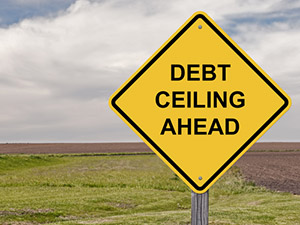
The debt ceiling deadline is Wednesday, March 15, 2017, and the reinstatement of the debt ceiling could spell disaster for the current bull market. Fortunately, we've created an investment plan to weather any market volatility that comes after the debt ceiling deadline (which we'll get to in just a moment).
The debt ceiling was temporarily eliminated in October 2015 to prevent the government from defaulting on debt payments. At the time, there was also a reinstatement date in the measure. That date of March 15, 2017, has arrived this week.
Here's a closer look at exactly what will happen at the debt ceiling deadline...
What Every Investor Needs to Know About the Debt Ceiling Deadline
The debt ceiling is the maximum amount the government is allowed to borrow to operate. The spending that goes towards the deficit, and by extension the debt ceiling, is approved by Congress in the annual budget. Right now, there isn't a debt ceiling because it was suspended.
Once the debt ceiling has been reached, the Treasury cannot borrow any more money to fund the government. At this point it will need to decide what gets paid and what doesn't to extend the use of the cash on hand. After the cash is spent, the government defaults on its obligations, including debt, if the ceiling has not been raised.
When the debt ceiling is reinstated, the new ceiling will expand to accommodate any new debt the government has taken on while the ceiling was suspended. However, it will not leave room for additional financing. The debt ceiling will be reinstated at a level of about $20 trillion.
On March 8, Treasury Secretary Steven Mnuchin wrote to Congress urging them to raise the debt ceiling by midnight on March 17. The debt ceiling needs to be raised to prevent "extraordinary measures" from going into effect to avoid the U.S. defaulting on its debt obligations.
The "extraordinary measures" is a cut of all nonessential government spending. By cutting the nonessential spending, the government will not have enough cash to fund operations until sometime this fall. At that point, if the debt ceiling is not raised, the U.S. government will default on debt payments.
If the debt ceiling isn't raised, extreme market volatility could result as investors begin to fear a possible default for the first time in U.S. history.
The volatility this type of uncertainty will create could put an end to the bull market we have enjoyed over the last eight years. There is even a chance the fear of a default and government shutdown could cause a market correction. That's why we've created the following three-step strategy to help protect your money from market volatility...
Investing After the Debt Ceiling Deadline
While it is unlikely that the United States will default on payments, it is possible the country's credit rating will be downgraded. That will result in a lot of nervous investors, especially if the decision goes down to the wire like it did in October 2015.
[mmpazkzone name="in-story" network="9794" site="307044" id="137008" type="4"]
Editor's Note: Timing is everything when it comes to making money in markets - and this new, free service we created puts timing on your side...
However, there are three steps you can take now in order to protect your investment portfolio. Those steps are evaluating your exposure to risk, investing in "Unstoppable Trends," and investing in gold.
To assess your exposure to risk, make sure all of the companies you are invested in are high-quality companies with strong operations. These companies should be able to weather a storm if it comes.
A good example is Raytheon Co. (NYSE: RTN). This company is "recession-proof" since it provides a service governments around the world need no matter what happens in the financial markets: defense systems.
The company has also been expanding operations, leading to a gain of 8.6% year to date (YTD) for the stock. This means that Raytheon is outperforming the Dow, which has only gained 5.4% YTD.
To help you find other strong companies, Money Morning Chief Investment Strategist Keith Fitz-Gerald recommends investing in "Unstoppable Trends." This is the second step in protecting your money.
These trends include demographics, healthcare, scarcity/allocation, war/defense, technology, and energy. Fitz-Gerald explains the Unstoppable Trends and companies to invest in here.
The last step to take to protect your investment portfolio is investing in gold. You see, gold is an excellent safe haven. While volatility sends stocks down, gold goes up as investors flock to the precious metal. This makes gold a great way to protect your portfolio of investments as volatility increases.
However, bars of gold are not practical for many investors since storing and acquiring them can be expensive. A way around this is to invest in a gold ETF. The one we recommend is SPDR GOLD Trust (NYSE Arca: GLD).
Remember, the time to prepare for a pullback is before it happens.
Don't Miss: A perfect storm is brewing... bringing with it the greatest wealth event in 20 years. And it involves a completely unique "gold" play. The cash windfall from this rare event is expected to reach a whopping $13 billion. Find out more.


